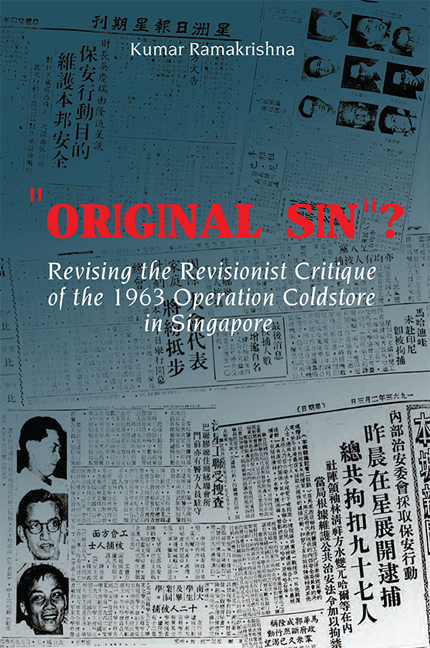Book contents
- Frontmatter
- Contents
- Acknowledgements
- Introduction: The “Alternate” Challenge to the Singapore Story as Context
- 1 Government Sources: Who Uses Them, and the Alternates’ Unarticulated Ideological Outlook
- 2 Was there Really a Dangerous Communist United Front?
- 3 The Curious Case of Lim Chin Siong
- 4 Why “Was Operation Coldstore Driven by Political and Not Security Grounds?” is the Wrong Question
- Conclusion: The Enduring Need for a Singapore Story 2.0
- Bibliography
- Index
- About the Author
Introduction: The “Alternate” Challenge to the Singapore Story as Context
Published online by Cambridge University Press: 19 May 2017
- Frontmatter
- Contents
- Acknowledgements
- Introduction: The “Alternate” Challenge to the Singapore Story as Context
- 1 Government Sources: Who Uses Them, and the Alternates’ Unarticulated Ideological Outlook
- 2 Was there Really a Dangerous Communist United Front?
- 3 The Curious Case of Lim Chin Siong
- 4 Why “Was Operation Coldstore Driven by Political and Not Security Grounds?” is the Wrong Question
- Conclusion: The Enduring Need for a Singapore Story 2.0
- Bibliography
- Index
- About the Author
Summary
While the first-ever school textbook on Singapore history — encompassing the period from the founding of modern Singapore by Sir Stamford Raffles in 1819 to independence from the Federation of Malaysia in 1965 — appeared in 1984, the more or less formalized “master narrative” of Singapore's ensuing political evolution, the so-called Singapore Story, “coalesced in the late 1990s”. This was “when the key moments in the country's political history as an emerging postcolonial entity were identified and plotted into a national narrative”. In 1997, then Deputy Prime Minister Lee Hsien Loong formally launched the National Education (NE) programme, an official attempt to redress the prevailing poor knowledge of Singapore's past on the part of young Singaporeans, many of whom had apparently not even realized that Singapore was once part of the Federation. The ultimate aim of the NE programme was to ensure that future generations of Singaporeans were adequately socialized into the Singapore Story, regarded as “objective history, seen from the Singaporean standpoint”. This exercise was by no means idiosyncratically Singaporean. New nations, ever since the emergence of secular nationalism as a potent unifying ideology in Europe in the late eighteenth century, have tended “to rely on skillfully constructing the connections between the past (real or imagined), the present and the future”. The purpose of deliberately crafting such national narratives has been “to encourage members of a putative national community to imagine themselves as sharing a special bond and destiny as members of a nation”. Hence in Singapore, it is acknowledged that government efforts “at yoking history to the cause of nation-building”, even “if particularly insistent and didactic”, are not unusual, for a “national history” that possesses “resonance and credibility” helps “foster national identity”.
- Type
- Chapter
- Information
- Original Sin?Revising the Revisionist Critique of the 1963 Operation Coldstore in Singapore, pp. 1 - 11Publisher: ISEAS–Yusof Ishak InstitutePrint publication year: 2015

